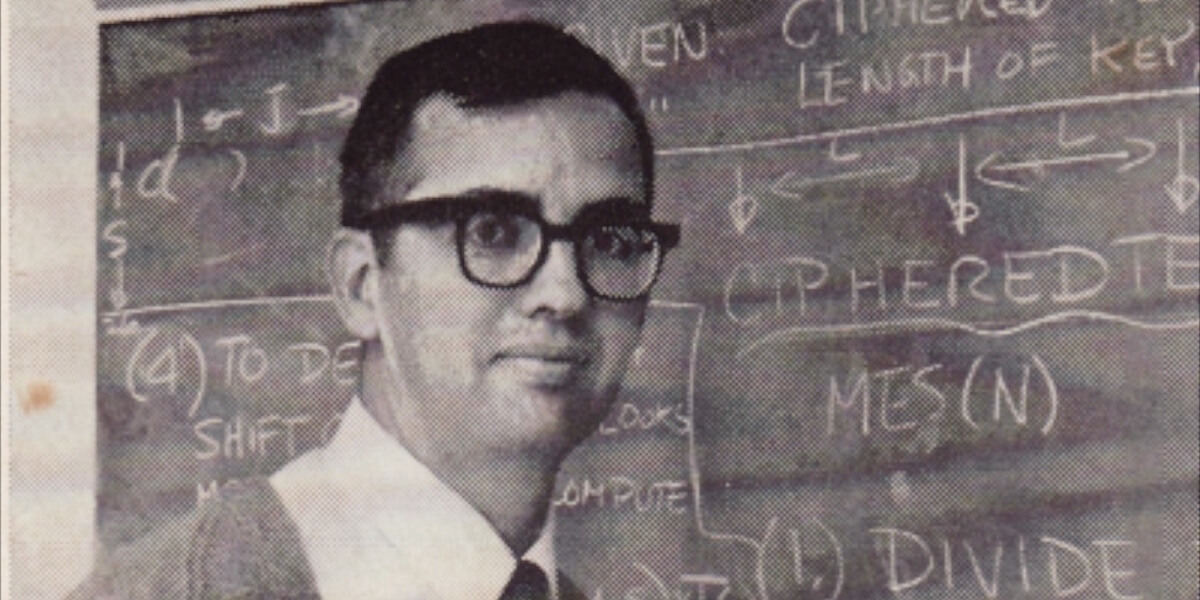
By Bob Scholtz, Fred H. Cole Professor of Engineering
It’s amazing what playing tennis can do for an engineer’s career – something similar to how golf can help businessmen and politicians. For most of my professional life I was a member of the Communication Theory Committee of the IEEE Communications Society, and tennis was the physical activity that accompanied this group’s workshops. One of my regular opponents was Paul Green, a sharp MIT Ph.D. and Lincoln Laboratory alum, and then head of IBM Research. Once at a 1979 workshop, after a couple of close sets of tennis, Paul said that he had read my paper, “The Spread-Spectrum Concept”, one of the earliest unclassified papers on the subject, and thought that I might be interested in a writing project. A decade or so earlier, Paul had started to write a history of spread-spectrum (SS) development at Lincoln Laboratory. Since its conception, this novel form of anti-jam communications had been classified SECRET by DoD. Then, on a trip to the Soviet Union, Paul sensed that the Soviets did not know of spread-spectrum techniques and he tabled the writing project. He offered his files to me if I decided to take up the writing effort.
I suggested, and Paul agreed, that we meet at the next workshop and I’d record an interview with him about Lincoln Laboratory’s work that resulted in the development of the F9C system, an HF radio with embedded spread-spectrum technology. When Paul showed up for the interview with two thick, bound folders of appropriately declassified Lincoln documents and told me about their work, I was hooked and agreed to give the spread-spectrum history writing effort my best shot.
After one of these intense calls, I remember dreaming that I was being run over by a steamroller driven my collaborator!
While I’m not a trained historian, I view writing history as a form of factual story telling requiring an extensive base of information. I had not worked as an engineer on any spread-spectrum radio hardware, but Paul had given me a nice chunk of historical evidence. One thing that the younger readers of this yarn must realize is that at the time, there was only the ARPANet; no internet, no Google, no way to access large amounts of information remotely. In fact, we didn’t even have the Microsoft Operating system or Microsoft Word. The TeX typesetting language was in its infancy, and personal computers were just beginning to be available. Indeed I purchased an Apple IIc and wrote my own word processing software and driver for a Paper Tiger dot-matrix printer (all in Basic) – what a relief not to cut and paste paper when trying to write a history piecemeal as sources revealed themselves. The gradual assembling of the history was done completely on this primitive home computer.
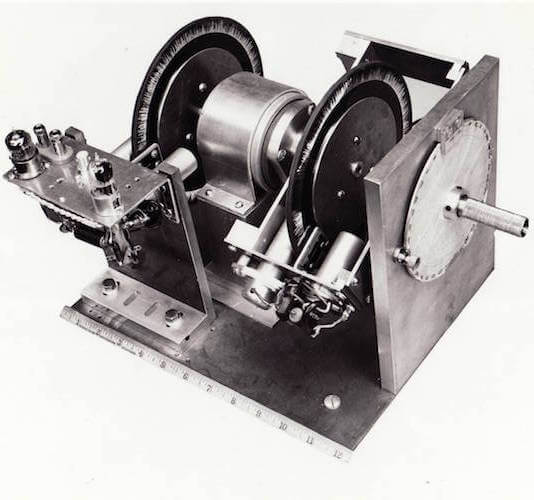
PSEUDO-NOISE SIGNAL STORAGE, BENCH TEST CONFIGURATION, OPTICAL TECHNOLOGY CA. 1950, ITT. TODAY, THE FUNCTION OF THIS OPTICAL TECHNOLOGY CAN BE ACCOMPLISHED DIGITALLY BY A SINGLE CHIP. PHOTO CREDIT: BOB SCHOLTZ ARCHIVE
The most difficult problem was accessing historical documents and interviewing the people who had done the hands-on spread-spectrum system development (that ground-breaking work having taken place mostly between 1940 and 1960). Some of these key players had already passed away and a few more died before the history was printed. Many of the patents and documents were still classified. I knew that some work on SS had been done at JPL in Pasadena CA and some at Magnavox Research Labs in Torrance CA, both conveniently nearby for me. But what about the rest of the USA (and the world)? Except for Lincoln Laboratories, my historical coverage would seem quite provincial. Paul Green came to the rescue when he connected me with Bob Price, his close friend and colleague from MIT, then a senior scientist at Sperry Research Center in Sudbury, Massachusetts.
I had met Bob once before but not in a working environment. We got together and Price and I agreed to split up research efforts — I would explore the west coast sources (JPL, Magnavox, etc.) and Price would explore the east coast connections. In addition Bob put the resources of the Sperry library to work, and Price himself spent many hours at the Boston library searching its microfilmed copies of the US Patent Office files. Bob was a formidable researcher with bulldog tenacity and soon every week or two I would receive an inch-thick brown envelope full of document copies, patents, and notes compiled by him and the Sperry librarian. That typically would be followed by a phone call on the weekend, often going from 4 in the afternoon to 10 or 11 at night and occasionally much, much later. What time would that be on the east coast? After one of these intense calls, I remember dreaming that I was being run over by a steamroller driven my collaborator! Bob later told me that he did receive a few comments from his boss about his phone bills. Anyway, I then would add these nuggets from Bob into the text on my homemade word processor and ship a Paper Tiger printout back to Bob.
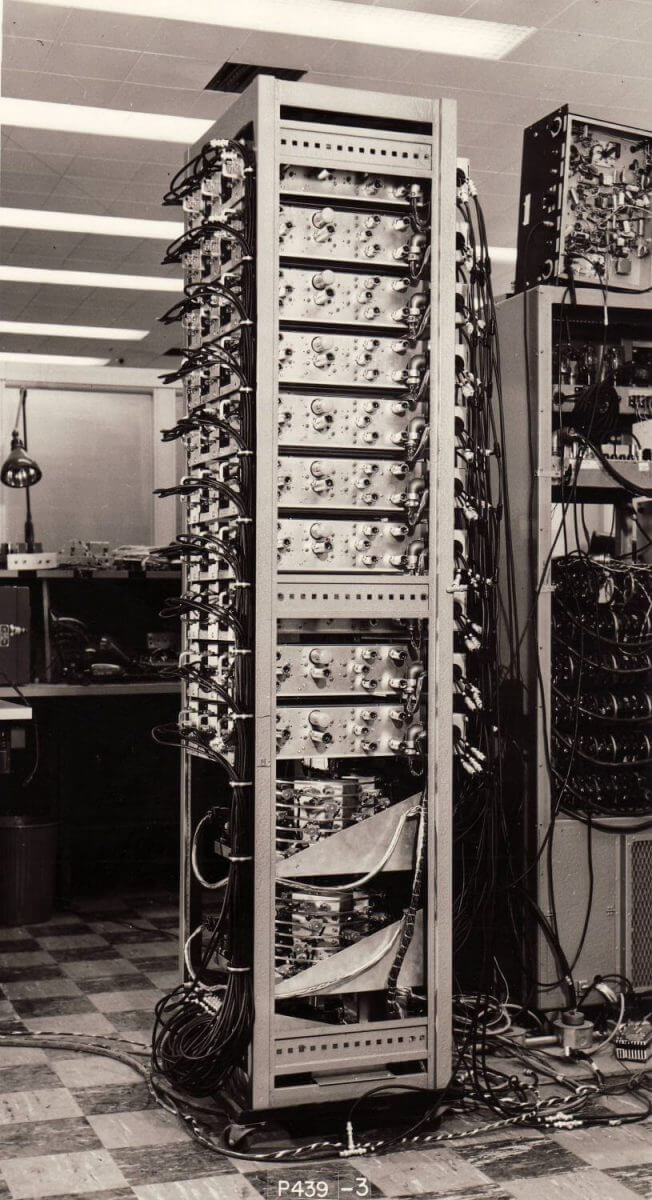
Rake adaptive combiner, vacuum tube technology ca. 1955, MIT. Another technology that now resides on a single chip. Photo Credit: Bob Scholtz Archive.
Uncovering a source could be difficult. For example, to find out more about JPL’s work, Sol Golomb suggested that I contact Eberhard Rechtin, then President of the Aerospace Corporation, who had started his career at JPL. Finally I reached Eb on the phone, and he knew just what I needed – he had written A History of CODORAC, a JPL document recounting their work on a system with spread-spectrum technology at its heart. There was only one problem: It was still classified 20 years after the work was done. Eb put me in touch with Walt Victor at JPL who worked to get that history declassified and produce a copy which could be read and quoted without any issues. Then it was only a matter of digesting the contents of the huge document to find the few morsels that fit neatly into the SS history.
After a while the search for facts and references became all-consuming – and contagious. I had mentioned to my wife, Lolly, that I was looking for a book by R. V. Jones which contained his personal viewpoint, as Winston Churchill’s military intelligence advisor, concerning radar jamming and “the battle of the beams”. Months later we were walking through Blackwell’s, a famous bookstore in Oxford, England, when Lolly had an urge to take a particular book off a shelf crammed with attractive volumes — and there it was, Jones’s book, with a bonus of newspaper clippings saved by the previous owner. Wow! A gem discovered (but no spread-spectrum technology)!
Most of the factual information that Bob Price and I collected made it into the final version of The Origin of Spread-Spectrum Communications, but not all. A half year before the SS history was put to bed, I received one of Price’s brown envelopes containing a remarkable discovery. Hedy Lamarr (aka Hedwig Keisler Markey), a movie actress born in Austria and then part of the Hollywood elite, had co-invented and patented a spread-spectrum system of the frequency-hopping type in 1943, preceding later definitive work by several years. Price, who was put on the trail of Hedy Lamarr by his journalist sister who wrote about patents, asked that I leave this nugget out of my writing so that he could introduce it in a paper containing his observations about SS history, and so it was.
After this three-year writing effort, even I was surprised by the numbers: a 33 page history based on 188 references, 67 interviews, and the assistance of 10 librarians/historians.
When it came time to publish the history, I asked Bob Price to be my co-author, but he declined, saying that he was too close to the history’s content, having been a key person in the development of the F9C system at Lincoln Laboratory. And after all, he had been repaid many fold by the wonderful experience of interviewing Hedy Lamarr in person in New York! Later I found a copy of Hedy’s autobiography “Ecstasy and Me” and sent it to Bob with many thanks for his contributions.
After this three-year writing effort, even I was surprised by the numbers: a 33 page history based on 188 references, 67 interviews, the assistance of 10 librarians/historians, and the comments and encouragement of many more. After reviews by several highly qualified readers, this history was finally published in 1982 with no significant changes.
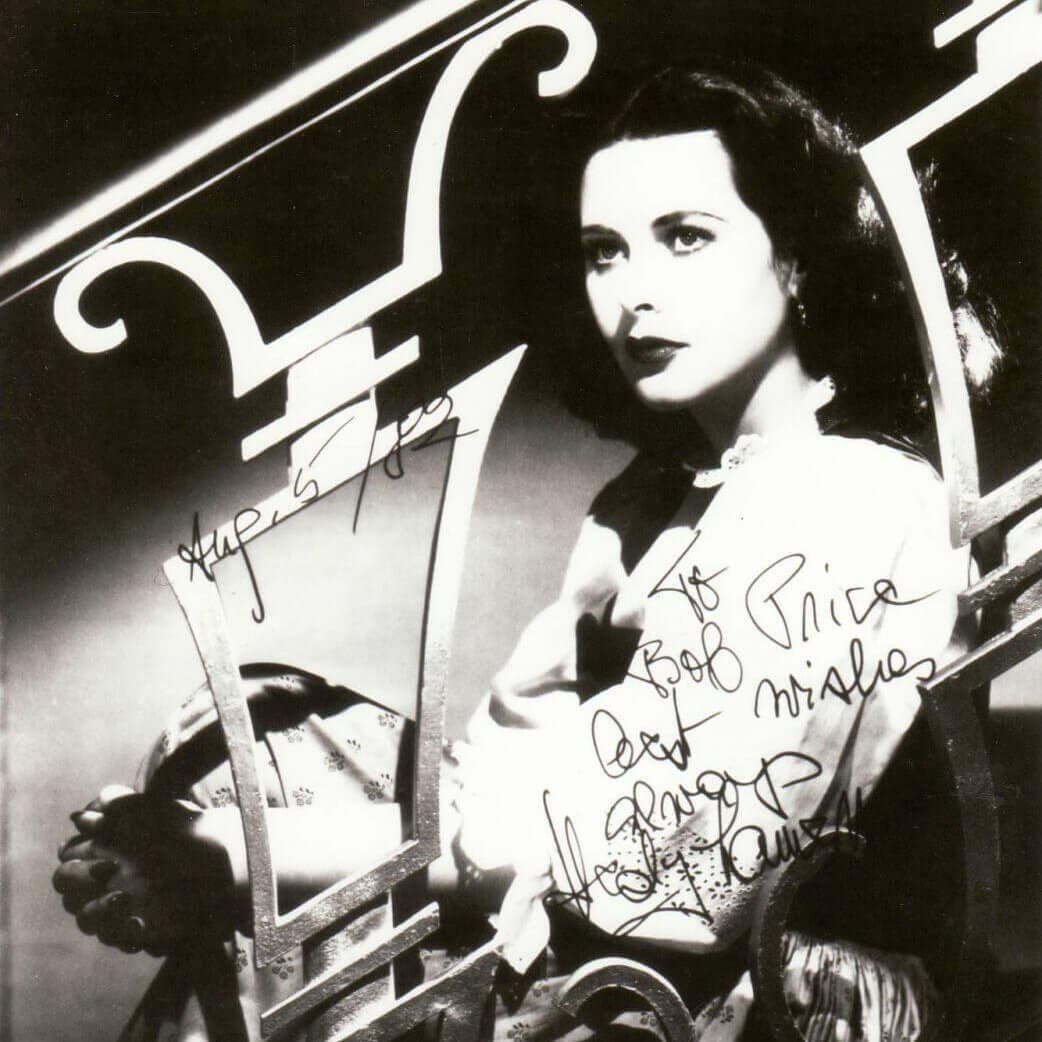
An autographed photo, dated August 5th, 1982, from the actress and engineer Hedy Lamarr, to Scholtz’s collaborator Bob Price. The caption reads “To Bob Price, Best Wishes, Always, Hedy Lamarr.” Photo Credit: Bob Scholtz Archive
Postscript: “The Origins of Spread-Spectrum Communications” received the Leonard G. Abraham Prize from the IEEE Communications Society and the Donald J. Fink Prize from the IEEE for the Outstanding Tutorial Paper of 1982. The history, augmented by the Hedy Lamarr story, appears as Chapter 2 in the Spread Spectrum Communications Handbook. The story of this remarkable actress captured the fancy of communication engineers, and prompted the organizing committee of MILCOM’97 to invite Hedy’s son, Anthony Loder, to speak at the conference banquet. Anthony stole the show – he held up his Qualcomm cell phone and stated unequivocally that “My mother invented this!” Then he dialed a number and the audience heard a conversation something like this:
“Hi Mom, how are you? . . . I’m fine. Listen, I’m at this convention of communication engineers. . . . I’m giving a speech and telling them about your invention. . . . What would you like to tell them?”
Tony held his cell phone up to the microphone so all could hear:
“Just tell them to keep up the good work!”
Game. Set. Match!
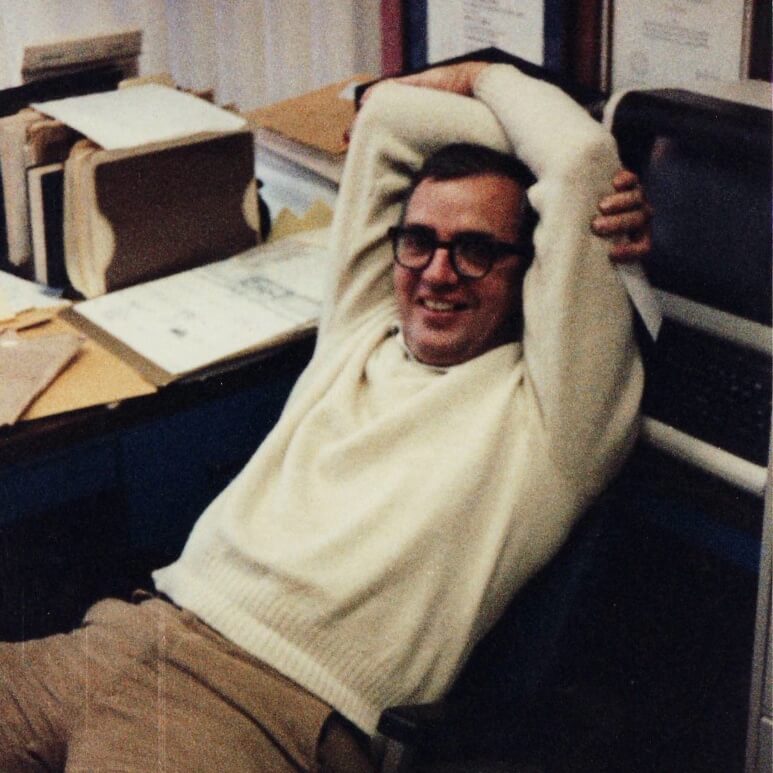 Bob Scholtz is the Fred H. Cole Professor of Engineering in the Ming Hsieh Department of Electrical Engineering and an IEEE Fellow and a member of the National Academy of Engineering. He co-founded the University’s Communications Sciences Institute (CSI) in 1982.
Bob Scholtz is the Fred H. Cole Professor of Engineering in the Ming Hsieh Department of Electrical Engineering and an IEEE Fellow and a member of the National Academy of Engineering. He co-founded the University’s Communications Sciences Institute (CSI) in 1982.
One of the department’s “Magnificent Seven,” along with Bob Gagliardi, Sol Golomb, Bill Lindsey, Irv Reed, Chuck Weber, and Lloyd Welch, he joined USC in 1963 where has has been working on communications and radar technology ever since.
Published on November 20th, 2017
Last updated on April 6th, 2021


